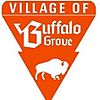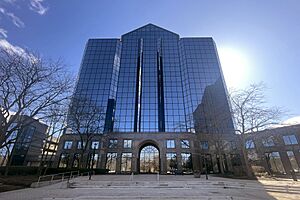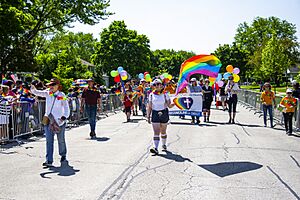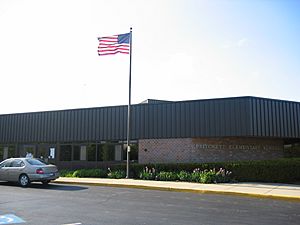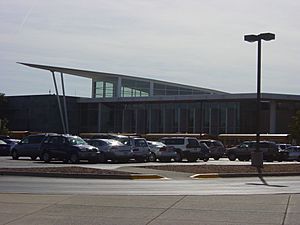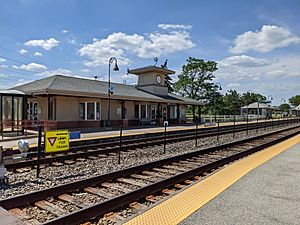Buffalo Grove, Illinois facts for kids
Quick facts for kids
Buffalo Grove, Illinois
|
|||
|---|---|---|---|
|
Village
|
|||

Sign welcoming drivers into Buffalo Grove
|
|||
|
|||
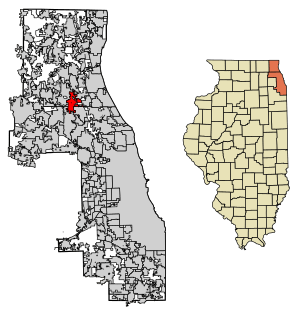
Location of Buffalo Grove within Lake and Cook County
|
|||
| Country | United States | ||
| State | Illinois | ||
| County | Lake and Cook | ||
| Townships | Vernon and Wheeling | ||
| Incorporated | 1958 | ||
| Government | |||
| • Type | Council-manager | ||
| Area | |||
| • Total | 9.58 sq mi (24.81 km2) | ||
| • Land | 9.56 sq mi (24.77 km2) | ||
| • Water | 0.02 sq mi (0.04 km2) | ||
| Elevation | 682 ft (208 m) | ||
| Population
(2020)
|
|||
| • Total | 43,212 | ||
| • Density | 4,518.67/sq mi (1,744.63/km2) | ||
| Time zone | UTC-6 (CST) | ||
| • Summer (DST) | UTC-5 (CDT) | ||
| ZIP code(s) |
60089
|
||
| Area code(s) | 847 and 224 | ||
| FIPS code | 17-09447 | ||
| GNIS ID | 2397490 | ||
| Commuter rail | |||
Buffalo Grove is a village in Lake and Cook Counties in the U.S. state of Illinois. It's a suburb of Chicago, located about 30 miles (48 km) northwest of Downtown Chicago. It's also about 20 miles (32 km) north of O'Hare International Airport. In 2020, Buffalo Grove had a population of 43,212 people. The village covers about 9.6 square miles (25 km2) of land. Most of it is in Lake County, with a smaller part in Cook County. Buffalo Grove is part of the larger Chicago Metropolitan Area.
Before European settlers arrived, Native American Potawatomi tribes lived in this area. The name "Buffalo Grove" comes from the Potawatomi name for Buffalo Creek. This creek flows through parts of the village. The first settlers sold their land to German immigrants who were Catholic farmers. These immigrants built St. Mary's Church and a school. The area stayed small and rural until new houses were built after the Korean War. Buffalo Grove became an official village in 1958. After that, its population grew a lot for the rest of the 20th century. The village celebrated its 50th birthday in 2008.
Buffalo Grove has many fun places and events. These include parks, two golf courses, and the popular "Buffalo Grove Days" festival. There's also a Farmers' market that runs for several months. The village is run by an elected council-manager government. This means a village board makes decisions, and a manager handles daily operations. The village's public works department is recognized nationally for its quality. People in Buffalo Grove work in healthcare, education, and other professional jobs. Businesses in the village provide jobs for 20,000 people.
Contents
- Exploring Buffalo Grove's Past: A Look at Its History
- Where is Buffalo Grove? Its Geography
- Who Lives in Buffalo Grove? Demographics
- What Drives Buffalo Grove's Economy?
- Arts, Culture, and Fun in Buffalo Grove
- Sports and Fun Activities in Buffalo Grove
- Learning in Buffalo Grove: Schools and Education
- How Buffalo Grove Works: Infrastructure
- Famous People from Buffalo Grove
- See also
Exploring Buffalo Grove's Past: A Look at Its History
Early Days: Before Buffalo Grove Became a Village
The first people to live in this area were the Illinois Confederation tribes. They mostly lived in central Illinois. In the 1700s, other tribes like the Iroquois and Potawatomi moved into the area. The Potawatomi became the main group and lived near what is now Buffalo Grove until 1833. French explorers, like Father Jacques Marquette and Louis Jolliet, were some of the first Europeans to visit in 1673. They traded with the Ojibwe people.
Over time, wars and diseases affected the Native American tribes. American settlers also moved westward, which made it harder for the tribes to find food. In 1829, some Potawatomi leaders signed a treaty. This treaty gave up land, including what is now Lake County. In return, they received money, gifts, and a blacksmith shop. However, the tribes could not stay on their land because more settlers kept coming. They signed another treaty in 1833, which opened the area for white settlement. Many Native Americans moved to reservations in other states or to Canada.
The first white settler in Vernon Township was Daniel Wright in 1833. The first settlers in Buffalo Grove were from New England. They sold their land to Catholic German immigrants who were looking for better lives. These immigrants built the St. Mary's Roman Catholic Church and St. Mary's School in the 1850s. These buildings are still there today. Buffalo Grove grew slowly in the 1800s. It added the first school, the Firnbach Tavern, and the Weidner General Store. The General Store was very important. It served as the post office, train ticket office, and even had the town's first telephone. Before World War II, Buffalo Grove was a small farming area with fewer than 150 people.
How Buffalo Grove Became a Village and Grew
Farmers eventually sold their land to developers. One developer, Al Frank, started building houses in the 1950s. These homes were for veterans of World War II and the Korean War. Many people wanted single-family homes near Chicago. This led to many new families moving to Buffalo Grove. Al Frank helped make Buffalo Grove an official village in 1958. He wanted his housing developments to be separate from Chicago's city planners. When it became a village, Buffalo Grove had 164 people.
As more people moved in, the village grew and added more land. The government quickly started planning for the future. They created groups to plan land use and parks. Alcott School opened in 1960. In 1962, the first "Buffalo Days" festival was held. A new village flag was also chosen, showing a buffalo, green leaves, and gold bands.
In the 1970s, Buffalo Grove's population grew by 80 percent. This was one of the fastest growth rates in the area. The village continued to add new neighborhoods. It also gained "home rule" status, which gave the local government more power to solve problems. Besides homes, new business areas were built, like the Buffalo Grove Commerce Center in 1981. Other business parks followed in the 1980s. Important buildings like Buffalo Grove High School, Adlai E. Stevenson High School, and the public libraries were also built in the 1970s. In 1992, Buffalo Grove got its own post office. This was the first main postal facility built in the U.S. in 20 years. In 2006, Buffalo Grove became one of the first places to ban smoking in public places.
Where is Buffalo Grove? Its Geography
Buffalo Grove is a suburb of Chicago in the northeastern part of Illinois. Lake Cook Road divides Buffalo Grove into two parts. About three-quarters of the village is in Lake County (in Vernon Township). The other part is in Cook County (in Wheeling Township). These two parts are a bit different from each other and from nearby towns.
Buffalo Grove shares borders with several other towns:
- Wheeling to the southeast
- Arlington Heights to the southwest and south
- Riverwoods and Deerfield to the east
- Lincolnshire to the northeast
- Vernon Hills to the north
- Long Grove to the west and northwest
There are also two small parts of Prairie View (not officially part of a town) within Buffalo Grove.
Buffalo Grove covers about 9.58 square miles (24.81 km2). Most of this is land, with a small amount of water. Willow Stream Park is the biggest park in Buffalo Grove, covering 54 acres. It has picnic areas, playgrounds, sports fields, and bike paths. Buffalo Creek is a forest preserve next to Buffalo Grove. It used to be a tallgrass prairie with wetlands. Today, it's a home for birds like bobolinks. In the 2010s, new trails and boardwalks were added. Buffalo Creek also helps control floods. Buffalo Grove is part of the Des Plaines River area where water drains.
What's the Weather Like in Buffalo Grove?
Buffalo Grove has a humid continental climate with four distinct seasons. This is similar to Chicago's weather. The village gets about 28.93 inches (735 mm) of rain each year. The hottest temperature ever recorded was 104 °F (40 °C), and the coldest was -24 °F (-31.1 °C).
- Summers are hot and humid. July is the warmest month, with average daily temperatures around 84 °F (28.9 °C). It can reach 90 °F (32 °C) or higher about 16 days each summer.
- Winters are cold and snowy. Blizzards can happen, like in 2011. January and February are the coldest months. Average winter high temperatures are around 34 °F (1.1 °C).
- Spring and autumn are mild and shorter seasons.
Buffalo Grove is in USDA plant hardiness zone 5b.
Who Lives in Buffalo Grove? Demographics
| Historical population | |||
|---|---|---|---|
| Census | Pop. | %± | |
| 1960 | 1,492 | — | |
| 1970 | 12,333 | 726.6% | |
| 1980 | 22,230 | 80.2% | |
| 1990 | 36,427 | 63.9% | |
| 2000 | 42,909 | 17.8% | |
| 2010 | 41,496 | −3.3% | |
| 2020 | 43,212 | 4.1% | |
| U.S. Decennial Census 2010 2020 |
|||
| Race / Ethnicity (NH = Non-Hispanic) | Pop 2000 | Pop 2010 | Pop 2020 | % 2000 | % 2010 | % 2020 |
|---|---|---|---|---|---|---|
| White alone (NH) | 37,121 | 31,813 | 26,672 | 86.51% | 76.67% | 61.93% |
| Black or African American alone (NH) | 317 | 405 | 517 | 0.74% | 0.98% | 1.20% |
| Native American or Alaska Native alone (NH) | 16 | 32 | 36 | 0.04% | 0.08% | 0.08% |
| Asian alone (NH) | 3,613 | 6,625 | 11,865 | 8.42% | 15.97% | 27.46% |
| Pacific Islander alone (NH) | 5 | 17 | 6 | 0.01% | 0.04% | 0.01% |
| Other race alone (NH) | 44 | 65 | 115 | 0.10% | 0.16% | 0.27% |
| Mixed race or Multiracial (NH) | 368 | 499 | 1,057 | 0.86% | 1.20% | 2.45% |
| Hispanic or Latino (any race) | 1,425 | 2,040 | 2,854 | 3.32% | 4.92% | 6.60% |
| Total | 42,909 | 41,496 | 43,212 | 100.00% | 100.00% | 100.00% |
In 2020, Buffalo Grove had 43,212 people. This was a 4.1 percent increase from 2010. The village started with only 164 people when it became official. Its population grew quickly in its early years. This was because many people wanted to move to suburbs after World War II and the Korean War.
In 2020, the population of Buffalo Grove was:
- 72.2% White (67.9% not Hispanic White)
- 21% Asians
- 1.6% African American
- 0.2% American Indian or Alaska Native
- 0.1% Native Hawaiian or Other Pacific Islander
- 2.8% from two or more races.
- 6.8% of the population was Hispanic or Latino (of any race).
Most adults in Buffalo Grove have finished high school (97.7%). Many also have college degrees. The average value of a home owned by its residents was $332,300. The average household income was $115,951. Only 3.4% of the population lived in poverty.
Buffalo Grove has a large Jewish population, like many other suburbs in the northwest Chicago area. In the 20th century, Jewish immigrants moved from Germany and Eastern Europe to Chicago. Many of them became successful. Younger generations then moved to the suburbs. They were looking for open land, affordable homes, and single-family houses. By 1995, about 10 to 25 percent of people in the northern suburbs were Jewish. In Buffalo Grove, over 25 percent of the population was Jewish. In 1995, Buffalo Grove had six synagogues (Jewish places of worship).
Buffalo Grove's Asian population has also grown. In 2011, 16% of residents were Asian. By 2019, this number jumped to 21%. The main Asian groups in Buffalo Grove are Japanese Americans, Indian Americans, and Korean Americans. Families are attracted to the schools, housing, job opportunities, and safe environment. NeighborhoodScout often lists Buffalo Grove as one of the safest cities in the U.S.
Buffalo Grove attracts families who want a good place to raise children. In 2015–2019, about 35.5% of households had children under 18. Most households (65.9%) were married couples living together. The average household size was 2.66 people. About 41.6% of homes spoke a language other than English. The average age of people in Buffalo Grove was 41.7 years old.
What Drives Buffalo Grove's Economy?
| Buffalo Grove | ||
|---|---|---|
| Employment by industry in 2019 | ||
| Industry | Employment | Percentage |
| Education and health care | 4,410 | 19.4% |
| Professional, scientific, management | 4,175 | 18.3% |
| Manufacturing | 3,277 | 14.4% |
| Finance, insurance, real estate | 2,572 | 11.3% |
| Retail trade | 2,510 | 11.0% |
| Art, entertainment, recreation, food | 1,335 | 5.9% |
| Wholesale trade | 1,192 | 5.2% |
| Transportation, warehousing, utility | 883 | 3.9% |
| Other services | 733 | 3.2% |
| Construction | 686 | 3.0% |
| Information | 514 | 2.3% |
| Public administration | 405 | 1.8% |
| Agriculture, forestry, hunting | 79 | 0.3% |
| Total | 22,771 | 100% |
Buffalo Grove's economy includes several business parks, many stores, and professional services. About 20,000 people work in the village each day. They work in 10 million square feet of business and industrial buildings. Shopping areas include Town Center and Chase Plaza. The Town Center, built in the 1980s, has faced challenges over the years.
Buffalo Grove is strong in industrial businesses. In 2017, there were fewer empty industrial buildings in Buffalo Grove than in the wider Chicago area or the U.S. This shows that businesses wanted to be in the village.
The village government offers special deals to encourage companies to operate there. For example, Hines Supply is a big sales tax generator for Buffalo Grove. The village has a tax agreement with them that lasts until 2040. This agreement means the village gives back 60 percent of the sales tax collected from Hines Supply. The village also made a $7 million tax agreement to help Woodman's Markets open in Buffalo Grove. This store attracts shoppers from far away. Other companies with tax agreements include Business IT Source Inc. and ThermFlo.
In 2015, about 72.5 percent of Buffalo Grove residents had jobs. The unemployment rate was 3.5 percent, which was lower than Lake County's rate. Many residents worked in Chicago (15.9%) or in Buffalo Grove itself (5.7%).
In 2019, the top employers in Buffalo Grove were:
- Siemens Building Technologies (1,800 employees)
- I.S.I. (business consulting, 1,200 employees)
- ESS (business consulting, 550 employees)
- Plexus Corp (electronic parts, 370 employees)
- Veritas Document Solutions (commercial printer, 300 employees)
Other large employers include US LBM Holdings, LLC (which owns Hines Supply), the Village of Buffalo Grove, ARxIUM, Vapor Bus International, and Leica Microsystems Inc.
Arts, Culture, and Fun in Buffalo Grove
The Raupp Museum, run by the Buffalo Grove Park District, tells the story of the town. It starts with the Potawatomi people and goes up to the busy suburb it is today. The Raupp brothers gave their land to the Park District in 1964, hoping it would become a library or museum. The museum opened in 1979. It has two main exhibit areas and special changing exhibits. About 9,000 people visit each year. In 2014, the Buffalo Grove Park District opened the Community Arts Center. It has a theater and classrooms. The local theater group, Big Deal Productions, uses this theater.
The Buffalo Grove Town Center is a main shopping area. It has the Buffalo Grove Theater and Bowlero, a place for bowling, arcade games, and laser tag. The Buffalo Grove Invitational Fine Arts Festival used to be held here in mid-July. Over 30,000 people would visit it. The last festival was in 2011.
St. Mary's Church was built in the 1850s by the first Catholic settlers. It was rebuilt after a fire. The church has a Gothic style with spires and stained glass windows. In 1995, Buffalo Grove also had six synagogues.
Yearly Events and Celebrations
Buffalo Grove hosts about ten events each year. The biggest is Buffalo Grove Days in September. This festival lasts several days at Mike Rylko Community Park. It has carnival games, rides, craft booths, food, live music, and a parade. People from Buffalo Grove and nearby towns enjoy this festival.
Another popular event is the Farmers' Market. It's also held at Mike Rylko Community Park every Sunday morning from June to October. You can find local fruits, vegetables, coffee, and pastries there. Local businesses and non-profit groups also have booths.
On June 2, 2019, Buffalo Grove held its first pride parade. It has continued to host one every year. Other events include concerts, outdoor movies, a Green Fair, and Fourth of July Fireworks.
Libraries for Learning and Fun
The Indian Trails Public Library District serves the Cook County part of Buffalo Grove. It's located in Wheeling. This library has moved and changed many times since it started. In 2009, the one-millionth item was checked out from the library.
The Vernon Area Public Library District serves the Lake County part of Buffalo Grove. It's located in Lincolnshire. This library started in 1974 in a classroom. It moved to its current building in 1993. In 2019, people used over one million items from its collection.
Sports and Fun Activities in Buffalo Grove
Buffalo Grove has many parks and open green spaces. Nicole Park has a playground and open space. Willow Stream Park offers sports fields, courts, a pool, and playgrounds. Mike Rylko Community Park hosts festivals and events. The Buffalo Grove Fitness Center is also nearby. Emmerich Park has the Buffalo Grove Park District office and is where many baseball games are played. In total, Buffalo Grove has dozens of parks. The village also has 43 miles (69 km) of paths and sidewalks for walking and biking.
The Buffalo Grove Recreation Association (BGRA) is a non-profit group. It runs a youth baseball league for the community. It started in 1961 and has 1,500 players and 600 volunteers. They have different leagues, including "Buddy Baseball." This league pairs children with special needs with non-disabled buddies to help them play.
Buffalo Grove has two golf courses and one indoor golf facility. The Buffalo Grove Golf Course is one of the largest open spaces in the village. It's used for fun and also helps control floods. The Arboretum Club, opened in 1990, is an 18-hole course. The park district also has a large Golf Dome with a driving range and hitting stations.
Many famous athletes have come from Buffalo Grove:
- Felice Herrig: A kickboxer and mixed martial artist.
- Zach Borenstein: A baseball player who played in college and minor leagues.
- Andy Wozniewski: A former ice hockey player for the Toronto Maple Leafs.
- Brett Lebda: An ice hockey player who also played for the Toronto Maple Leafs.
- Megan Bozek: An ice hockey player for the U.S. national team.
- Bradie Tennell: An Olympic figure skater and two-time U.S. national champion.
Learning in Buffalo Grove: Schools and Education
Buffalo Grove has four private schools and more than ten public schools. It also has one public high school. Students in the Lake County part of Buffalo Grove attend schools in Aptakisic-Tripp Community Consolidated School District 102 and Kildeer Countryside Community Consolidated School District 96. High school students from Lake County go to Stevenson High School in nearby Lincolnshire. Students in the Cook County part of Buffalo Grove attend schools in Wheeling Community Consolidated School District 21. These high school students go to Buffalo Grove High School, which is located in the Cook County part of the village.
The schools in Buffalo Grove have changed as the community grew. The first school in Buffalo Grove was Alcott School, which opened in 1961. Other schools like Pritchett Elementary, Tripp School, and Meridian School were built in the 1980s to handle the growing number of students.
How Buffalo Grove Works: Infrastructure
Buffalo Grove uses several main roads for travel.
- North-south roads: Milwaukee Avenue (Illinois Route 21), Buffalo Grove Road, Weiland Road, and Arlington Heights Road.
- East-west roads: Dundee Road (Illinois Route 68), Lake Cook Road, Deerfield Parkway, Aptakisic Road, and Half Day Road (Illinois Route 22).
- Illinois Route 83 runs diagonally through the village.
O'hare International Airport is about 20 miles (32 km) south of Buffalo Grove. Thanks to Lake Cook Road, the village can easily access major highways like I-90, I-94, and I-294.
Pace provides bus service on several routes. There is a bus hub at the Buffalo Grove Metra station.
Train Travel: Metra Stations
The Buffalo Grove station opened in 1996. It is part of Metra's North Central Service line. This line offers daily train service for commuters between Antioch and Chicago's Union Station. The station is about 32 miles (51 km) from Union Station. In 2018, Buffalo Grove was the busiest station on the North Central Service line, with about 695 people boarding on weekdays. The train station is near the intersection of Weiland Road and Deerfield Parkway.
The Prairie View station is also used by Buffalo Grove residents. It's located north of Half Day Road and Prairie Road. This station is about 34.4 miles (55.4 km) from Union Station. The North Central Service trains mainly run during rush hour on weekdays. On weekends and most holidays, Buffalo Grove residents use other Metra stations like Arlington Heights, Deerfield, or Lake Cook Road.
Village Services: Utilities
Buffalo Grove gets its water from Lake Michigan. Commonwealth Edison provides electricity. The village buys water from the Northwest Water Commission and then distributes it to residents. Water travels through pumping stations and 181 miles (291 km) of underground pipes. The village also flushes hydrants, plows streets, and fixes water meters. There is a fee for stormwater management, which helps maintain storm sewers and other water systems.
Buffalo Grove has a contract with Waste Management, Inc. for trash and recycling. This includes "At Your Door (AYD) Service." This service allows residents to have hazardous and hard-to-recycle items picked up. These items include electronics, TVs, paint, and chemicals. In 2004, the Village of Buffalo Grove Public Works Department received national recognition for its excellent services.
Famous People from Buffalo Grove
Many actors, actresses, and musicians have lived in Buffalo Grove.
- Aaron Himelstein: An actor who played a younger Austin Powers.
- Vince Vaughn: A well-known actor who grew up in Buffalo Grove.
- Jessy Schram: An actress who played Cinderella in Once Upon a Time.
- Mike Kinsella and Tim Kinsella: Musicians in bands like American Football and Cap'n Jazz.
- Raymond Benson: An author who wrote some James Bond novels.
- Irwin Cohen and his son Aaron Cohen: Olympic judokas.
- Ronald Goldman: A victim in the O. J. Simpson case.
- Stefan Antonijevic: A Serbian-American soccer player.
See also
 In Spanish: Buffalo Grove para niños
In Spanish: Buffalo Grove para niños



